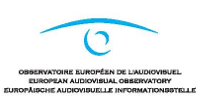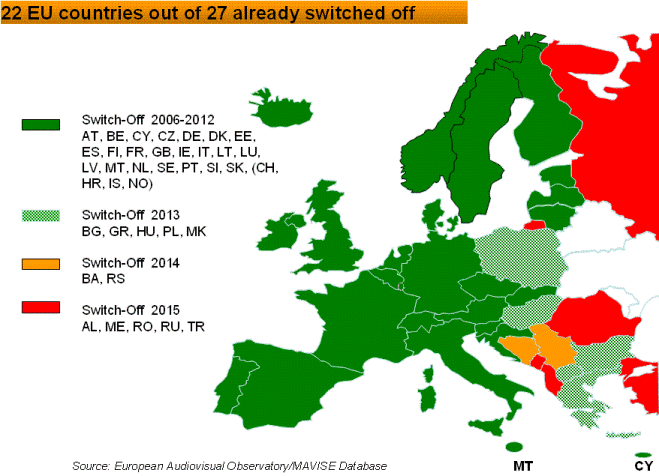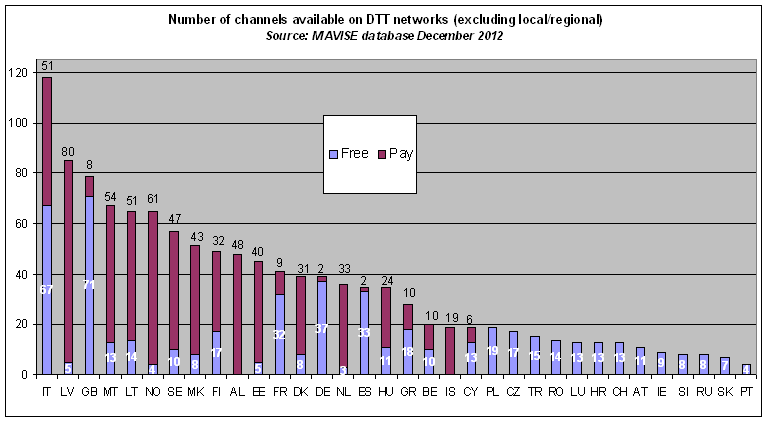22 of 27 EU countries implement analogue TV switch-off by end-2012
Monday, March 11th, 2013
22 of the 27 EU Member States have implemented the 2012 analogue TV switch-off in line with European Union recommendations
- 22 of the European Union Member States are now switched over to digital. Switch-off is also complete in Croatia, Switzerland, Norway and Iceland.
- Pay DTT services available in 17 EU countries and 21 European countries.
- 86 new DTT channels launched in 2012.
- HD channels available on DTT networks in 22 European countries.
- In 2012, 369 new television channels were launched (on all platforms) in the European Union and 40% of these broadcast in HD.
The Yearbook recently published by the European Audiovisual Observatory showed that the year 2012 was a significant watershed for digital terrestrial television in the European Union, as the EU had recommended the end of 2012 as a switch-off deadline for analogue terrestrial television. With the 2012 Switch-off in Ireland, Italy, Lithuania, Portugal, the Slovak Republic, and the United Kingdom, a total of 22 EU member States have hit the recommended deadline.
Croatia, Switzerland, Norway and Iceland have also already completed analogue switch-off (ASO) bringing the total to 26 countries out of the 39 Member States of the European Audiovisual Observatory which have completed the transition.
Fig 1: Status of DTT switch-over in Europe

Switch-off should be complete in Greece, Poland and Bulgaria in 2013 and Hungary should switch-off in 2013 or 2014 (along with the “Former Yugoslav Republic of Macedonia” and Bosnia and Herzegovina). Albania, Romania, Russia, Montenegro and Turkey have planned to complete the process in 2015. This will ensure that these countries meet the June 2015 deadline of the International Telecommunications Union (ITU) GE-06 agreement.
Development of pay-DTT services
At the end of 2012, DTT pay-TV platforms had been established in 21 countries, with a total of 33 pay-DTT services available. New services were launched in 2012 in Belgium and Greece. For the first time, the number of subscriptions to pay-DTT dropped in 2012 by an overall figure of 13% (according to Screen Digest data) with the most significant drop in Italy (almost 1 million subscribers).
At the same time some planned pay-DTT services in Spain and Portugal have not materialised, services have ceased elsewhere (Italy and France) and in several smaller countries the development of a financially successful model for pay DTT is proving difficult. In France while TV Numeric closed its service, a new DTT service is planned for 2013 involving a co-operation between Leclerc and TF1 Distribution.
On the other hand, pay-DTT services have long been established in certain smaller states such as Estonia, Malta, Lithuania, the “Former Yugoslav Republic of Macedonia”, and Albania where these pay services were launched in advance of free DTT. The dominance of pay DTT in some of these countries is outlined in Fig 2, below.
Local and HD channels increase on DTT networks
According to the MAVISE database, at the end of 2012, the number of channels available on DTT networks in the EU member states included the following: 456 free national or international channels; 529 pay channels, and more than 1,000 local and regional channels. For the 39 countries of the European Audiovisual Observatory the equivalent numbers are: 514 free national or international, 700 pay, and more than 1,000 local and regional channels. 86 new terrestrial channels were launched in 2012 (following 56 in 2011, and 50 in 2010). Many of these were new local DTT licences in Denmark. 21 new local television channels will appear on the DTT networks in the United Kingdom in 2013 with a new multiplex expected to be completed this year. An exact number of local TV providing TNT services is difficult to obtain in countries such as Italy or Spain. Fig.2 outlines the total number of channels (not including local or regional) available in 34 European countries.
The Italian networks have by far the most national channels, with the lowest offer available in Portugal. The table also indicates the importance of pay DTT for providing a variety of content in many countries. This is not however the case in the UK, France, Germany, Italy or Spain where a large amount of free content is available.
Fig 2: Channels on DTT networks in Europe: free and pay

There is increasing availability of high definition services (HDTV) on DTT platforms. Whereas at the end of 2009, HDTV was only available in two countries (France and the United Kingdom), at the end of 2012 there were HD channels on the DTT platforms in twenty-two European countries offering a combined total of more than 90 national DTT channels and 25 regional windows. Six new free-to-air HD channels were launched in France at the end of 2012.
Television market remains buoyant with 369 new channels in the European Union in 2012
Overall in 2012, 369 new television channels were launched in the European Union (on all platforms – DTT, cable, satellite, etc). More than 40% of these were channels broadcasting in HD (142 high definition simulcasts and 12 other HD specific channels). Hence the growth of HD channels has had a major impact on the overall growth of the market and represent a mix of genres including film (30), entertainment (30) and sport (28). When considering all channels in the MAVISE database (EU and ten other European countries) a total of 400 were launched in 2012.
In comparison to 2011 when 143 channels were closed down in the European Union, just 62 channels closed in 2012. These included the three local channels from the City TV network in Ireland, which were hit by the impact of the economic crisis. A total of 12 sports channels closed, mainly in Sweden and France; in Sweden this was due to the re-organisation of the CMore family of channels. In France, the Orange sport channels closed in 2012, in the context of the launch of the BeIN Sport channels by Al Jazeera.
The European television market as a whole consists of more than 11,000 European channels, of which 8,270 are established in the European Union
At the end of 2012, according to data from MAVISE there were more than 11,000 television channels available in the European Audiovisual Observatory’s 39 member states (8,270 in the EU 27 compared to 7,600 in 2011). Of the 11,000 channels available in Europe, 51% are regional or local channels and 49% are national and international channels.
Important genres and the content of HD channels: sport is still top
Regarding television channels available in Europe (on all platforms) the most predominant genres (when one excludes local and regional channels), are sport followed by entertainment channels, generalist channels, and film channels. In fact the genre with the highest number of channels is that of HD simulcast channels. In the entire HD universe the most important genre is sport (20%), followed by film channels (16%). The main generalist (both public and private) channels make up 13% of the HD channels, followed by entertainment channels (11%), documentary channels (9%) and channels focused on TV fiction (8%).
Latest News
- TargetVideo integrates AI for video content categorization
- Meta opens Meta Quest OS to third-party hardware makers
- Aferian to implement further cost reductions at Amino
- Paramount to exclusively represent SkyShowtime advertising sales
- Sky Sports Main Event latency reduced on Entertainment OS devices
- Netflix posts first quarter 2024 results and outlook